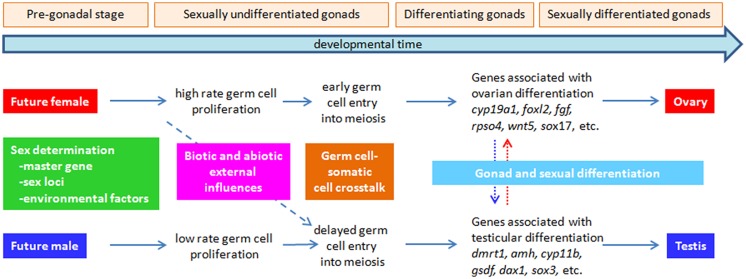FIGURE 1.
Major events leading to ovarian vs. testicular differentiation in fish. The first event, sex determination – the establishment of gender – can be triggered by the action of a major sex determining master gene, several sex-associated loci, an environmental factor (e.g., temperature) in an ecologically relevant context (i.e., occurring normally in the habitat of the species) or a combination of them, typically when the gonads are still sexually undifferentiated or even before they are formed at the most rudimentary stage (pre-gonadal stage). Successive events are connected by horizontal arrows and include differences in the proliferative rate of germ cells (females > males), which can be one of the first effects of the sex determining factor, whether genetic or environmental. During this period, the germ cell-somatic cell crosstalk is very important, but still largely uncharacterized. Also, during these early events, biotic and abiotic factors (e.g., stress, abnormally high temperature, etc.) can change the course of subsequent sex differentiation, usually in the female → male direction (diagonal dashed arrow). Finally, also at the beginning of gonad differentiation – the transformation of an undifferentiated gonad into a testis or ovary – the accidental (i.e., contamination) or deliberate (e.g., sex control treatment) incorporation of sex steroids, androgens or estrogens can result in female → male (vertical blue dotted arrow) or male → female (vertical red dotted arrow) sex-reversal, i.e., in that genotypic females and males develop into phenotypic males and females, respectively.

